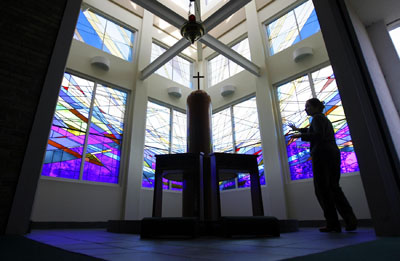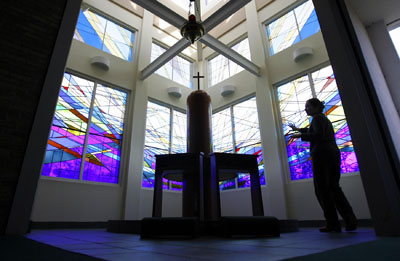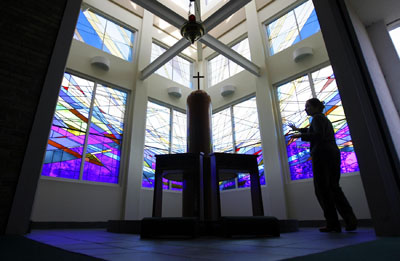
(RNS3-JAN22) Artist Ruth Goliwas talks about the stained glass she for Holy Family Catholic Church in Luling, La. For use with RNS-CHURCH-ARTIST, transmitted Jan. 22, 2009. Religion News Service photo by Brett Duke/The Times-Picayune.

(RNS3-JAN22) Artist Ruth Goliwas talks about the stained glass she for Holy Family Catholic Church in Luling, La. For use with RNS-CHURCH-ARTIST, transmitted Jan. 22, 2009. Religion News Service photo by Brett Duke/The Times-Picayune.

(RNS3-JAN22) Artist Ruth Goliwas talks about the stained glass she for Holy Family Catholic Church in Luling, La. For use with RNS-CHURCH-ARTIST, transmitted Jan. 22, 2009. Religion News Service photo by Brett Duke/The Times-Picayune.
NEW ORLEANS-It was nearly 25 years ago and Ruth Goliwas was a young, locally trained painter and printmaker when her agent approached her with a job query: Would she be interested in providing designs for a church sanctuary?
That was a little afield for Goliwas. But she had earned a degree in fine art from the University of New Orleans and was supporting herself through her talents, however they might be deployed.
So she said yes-and soon entered the world of liturgical art and design, immersing herself for the first time in the lives of saints, communities of faith, and clergy, whom she came to admire.
Collectively, they worked a change on Goliwas. And she brought them change, too, at least ornamentally.
Today, Goliwas describes herself as a person of active faith, a shift from her youth. And now her work-stained-glass windows, tabernacles, murals, statues, chairs and altars-is all over local Catholic churches-and at St. Giles’ Cathedral in Edinburgh, Scotland.
Goliwas designed the papal chair used by Pope John Paul II during his 1987 stop here; she also carved the design for bronze medallions embedded in a processional cross that preceded him to the altar.
She is one of about 10 artists working steadily in worship settings around New Orleans, and there is still plenty of work to go around after Hurricane Katrina, she said.
Much of her work is in stained glass, which, as a practical matter, is actually a pleasing assembly of pieces of colored glass and hand-painted pieces of clear glass that depict detailed images: faces, books, hands and the like.
But she also designs statuary to be executed by others; designs altars and furniture and baptisteries; and carves tabernacle fronts.
The work is a blend of art, design, construction know-how and hard-headed pragmatism, as when Goliwas discovered at the very last minute that, however it had looked on paper, the face of Christ was too dark-“didn’t read right”-when set in place in the newly finished Holy Family Church in Luling, La.
The solution: Chop the face out of a newly installed window, race back to her studio, paint and bake a new one-corrected for tone-and race back to get it up shortly before the archbishop’s arrival and the start of dedication ceremonies.
“There’s a lot of stuff people never know,” she said.
If, in the tradition of liturgical art, the images of Mary, the saints and Christian symbols make the faith present to the faithful, it seems to have done the same for the artist.
Early on, “I was very nonreligious,” Goliwas said. As the first liturgical commissions came in, the young artist said she offered God a trade: “If you can make this work for me, I’d love to do it. If you do, I’ll devote my life to it.”
But Goliwas said she got more than steady work.
Reared as an evangelical, a tradition that forswears ornamentation and ritual, Goliwas had no sense of the meaning of Catholic art she was being asked to create.
To understand what these pieces meant, she began reading accounts of the lives of the saints. She came to understand sacraments and ritual. She acquainted herself with Catholic liturgy and what it meant, how it worked and why.
“I wasn’t dragged in kicking and screaming. I loved it,” she said. “I found myself being seduced by something miraculous.”
Goliwas met priests and watched them at close quarters. She grew to admire them.
“I know there’s a lot of bad press about priests, but by and large they’re the most wonderful people I’ve ever met. They’re high caliber. Quality. Educated. Kind-hearted. Most of them are wonderful people.”
In the first weeks after Hurricane Katrina, Goliwas visited wrecked churches, full of the stink of mold and ankle-deep in slime.
“More often than not, I’d find them out with their shirt sleeves rolled up, mucking about in their churches with their people,” she said.
The fraternity those damaged communities offered their members touched her deeply.
“The riches came working with those people,” she said.
(Bruce Nolan writes for The Times-Picayune in New Orleans.)
KRE/AMB END NOLAN




